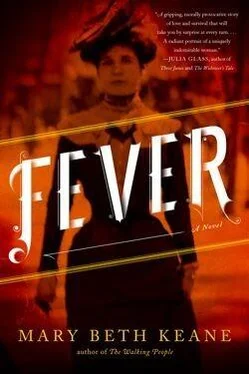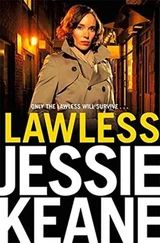She wore it. She stood in the small private room Mrs. Bowen had assigned to her as cook and slid one pin behind her left ear, and one behind her right. She felt its beauty like a living thing as she crossed the street, as she gathered her skirt and stepped as well as she could over the horse shit that had been pushed to the curb and left in a heap at the corner of Sixtieth Street. She felt it like a light shining over her as she made her way east to the streetcar on Third Avenue, still shining as she transferred to the IRT at Forty-Second Street. Mrs. Bowen was to have a dinner party that evening and wanted something unusual to serve to her guests — lobster, perhaps, or sweetbreads. No fowl, she instructed. No oysters. No pork. Nothing her guests might be served by their own cooks, in their own homes. Milton’s on Second Avenue had a good selection most days, and high turnover, but Mrs. Bowen didn’t trust them, and sent Mary instead all the way down to Washington Market, where she instructed Mary to witness with her own eyes the fish being pulled off the ice. It meant a morning’s journey and more work, just so Mrs. Bowen’s guests would go home and say to one another, That Lillian Bowen, she’d never serve anything as plain as a roast.
As she descended the staircase to the IRT on Forty-Second Street, she looked down for her next step with her eyes instead of bending her neck and risking the hat. She’d been on the IRT fewer than a dozen times since it had opened with great fanfare, and still found it jarring to see a train shoot out of the darkness so far underground, knowing as she stepped aboard that it would plow into the darkness on the other side. But the hat made her brave. On the train, she fixed her gaze on the doors as the rest of the world pushed in around her.
Because Mrs. Bowen had left the choice of dinner to her, she had to look at everything the market offered: twenty-five butcher stalls, all the vegetables, all the fruit, the cheese, the nine fish stalls, the smoked meat, the tripe. She sampled the coffee cake, the coffee, the dark bread, the light, the butter from Connecticut, the cheese from Virginia. She bought a nickel slice of Westphalian ham and ate it as she walked. She raised a hand to protect her hat against the flying feathers of the poultrymen, from the rough knuckle-cracking work of the butchers and the bits that flew in the air, the cartilage and marrow that made a slick circle around their stalls and forced women to walk on tiptoe until they were safely past.
She kept the hat on her head well enough, adjusting it now and again when it started to tip, and she made her way all the way back to Park and Sixtieth loaded down with packages. The other Irish at market had their hair covered in scarves. The European women from other parts wore tight braids coiled at the back of the neck, or old hats of their husbands’ pulled down over their ears. Heads had turned seeing Mary coming in that hat. Seas had parted. When she bargained and told them exactly how she wanted her packages wrapped, they knew she was a domestic, and yet that hat.
As Mary turned the last corner before the Bowen home, she caught sight of her reflection in a neighbor’s bay window and decided she was as pretty that day as she’d ever been. The coat hugged her figure — slim, back then — and her hair was shiny and clean. Her eyes were bright from the chill in the air, and her cheeks rosy from the effort of hauling her purchases. She was thirty-seven years old.
She turned onto Park to walk the half block uptown and who did she encounter in front of the residence but Mrs. Bowen herself. And what was Mrs. Bowen wearing on top of her curls? The identical twin to Mary’s beloved hat.
“Mary,” she said, her eyes fixed on Mary’s head. “I expected you ages ago.”
“I’m very sorry, madam,” Mary replied, even though Mrs. Bowen had no reason to expect her any sooner. She made a point not to look at Mrs. Bowen’s head, even though Mrs. Bowen had yet to take her eyes from Mary’s.
“You haven’t forgotten that the guests will arrive at six.” She narrowed her eyes as if deciding whether it really could be the same hat. A copy, perhaps? A poor imitation?
“No, I wouldn’t forget that.” Mrs. Bowen had called the office that had placed Mary to hire two additional cooks just for the afternoon, and Mary had stripped and scrubbed everything the day before. When Mary arrived at the Bowen residence three weeks earlier, the pots and pans were thick with baked-on carbon, and she spent her first week chipping it away, scrubbing them back to their original luster. While she was at it she tied a rag to the end of a broom and pulled the cobwebs from the tin ceilings. She went through a gallon of ammonia scrubbing the floor. No one knows where to find the pockets of grease in a kitchen like a cook knows, and when the other cooks arrived that afternoon, Mary saw them looking. And she saw them not finding.
Mrs. Bowen seemed satisfied, and though she still wore a curious expression, like she didn’t quite understand what she was looking at, she finally managed to tear her eyes away from the top of Mary’s head. She put her hand to her own hat for a moment, then turned to enter the house through the main entrance. Mary watched the other woman walk away, and as she felt the weight of the packages in her arms, the ache in her wrists and elbows from struggling with them for so long, on the IRT, on the streetcar, up and down stairs, across puddles and stubborn patches of ice left over in the shade of trees, the scald of the cold against her knuckles, she felt the words slipping from between her lips before she had a chance to stop them.
“I see we have the same taste,” she said to Mrs. Bowen’s back. It was a foolish thing to say, and as soon as the words were out she remembered her aunt observing once, years ago, that Mary had a twist in her that sometimes made her do and say things that she shouldn’t.
Mrs. Bowen turned. “I beg your pardon?”
“Your hat,” Mary said, nodding at the other woman’s head as if she might not know where to find her hat. “It’s identical to mine.”
“Oh,” Mrs. Bowen said, her hand reaching somewhere in the region of her ear, not touching the hat. “Similar, Mary, not identical. But I see what you mean.”
“Not the same?”
“No. Similar. Not the same.”
Mary knew that if she snuck into Mrs. Bowen’s quarters that night and switched their hats she would never in a thousand years of scrutiny have been able to tell the difference.
“My mistake.”
The servants’ entrance was just a few short steps down from the sidewalk but Mary barely made it inside before she started laughing. Bette and Frank were in the kitchen making preparations and could tell by Mary’s face she had a story to tell, so she told it, and they all had a laugh over Mrs. Bowen’s expression, which Mary did for them again and again as they unfolded the counters from their compartments and laid out the knives and waited for the additional cooks.
They laughed and laughed, and the work went quickly.
A week later, the daughter of the family declined all of her meals and told her governess that she felt poorly, and would have to do her lessons another time. By evening, her fever was so high she had to spend the whole night in the tub. One month later, Mary was taken away.
• • •
“Nonsense,” said John Cane, when Mary told him the whole story of the hat not long after she was moved to her private hut on North Brother. John had asked if she wanted to keep him company while he transferred to the ground some of the plants he’d started from seed over the winter. She was quiet, at first, content to watch him work, and then he’d asked how it was that they’d captured her, taken her to North Brother.
Читать дальше












